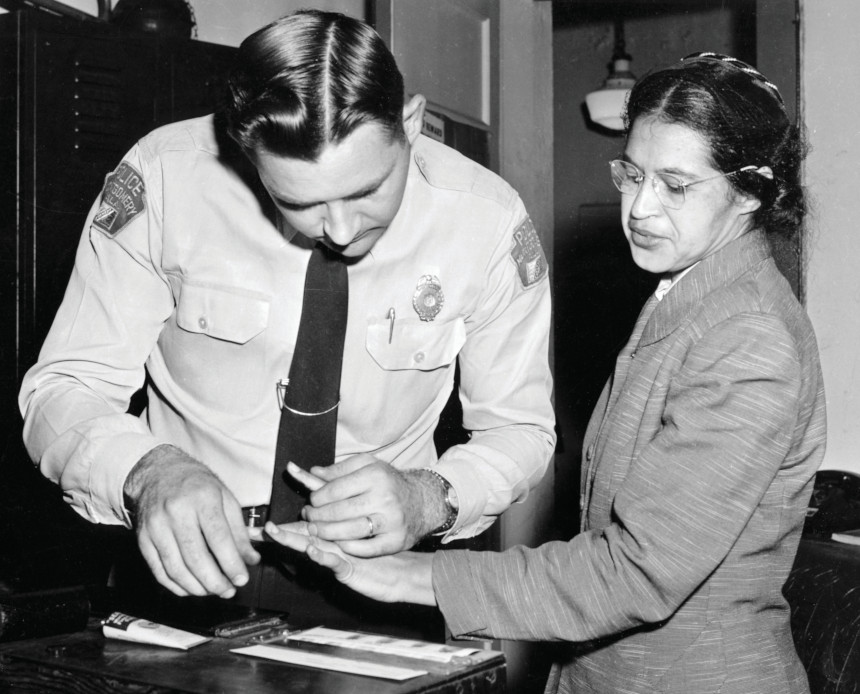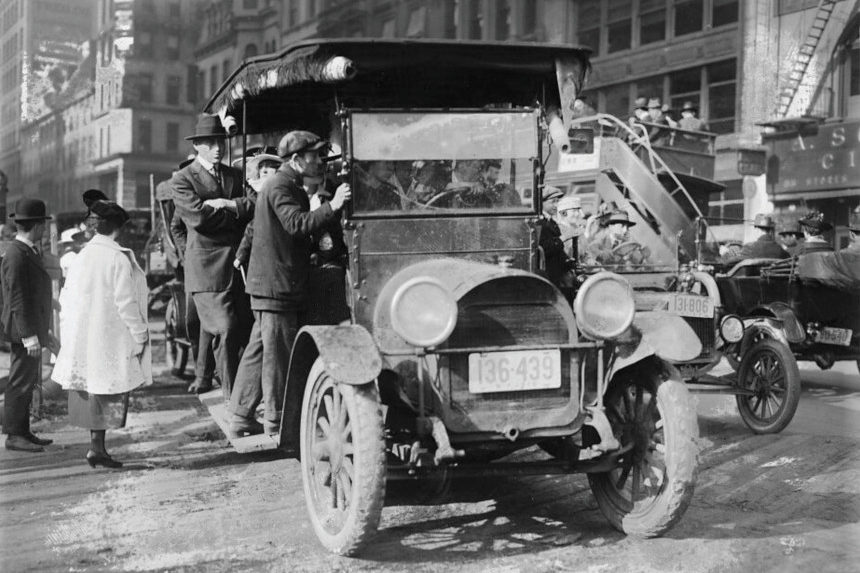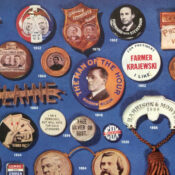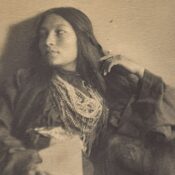On July 1, 1914, an enterprising motorist named L.P. Draper picked up a man waiting at a streetcar stop in Los Angeles, took him a short distance in his Ford Model T, and charged him a nickel for the ride. At the time, streetcars in most American cities had a flat fare of five cents, so Draper’s passenger was simply paying the going rate. Draper had invented a new model for urban transport: offering short rides in private cars for a flat fare. Draper had determined that this was entirely legal, provided he had a chauffeur’s license, which was easily obtained from the city authorities.
Once word got around, a few other drivers in Los Angeles began doing the same thing. Cars offering rides in this way came to be known as jitneys, after a slang term for nickel. Some drivers picked up a few riders while driving to or from their places of work. But an economic slowdown, which had begun in 1913, made operating a jitney an attractive option for anyone who had lost their job but owned a car and wanted a quick way to make a little money. A jitney driver, often in a Ford Model T, would typically cruise the main street of a city, looking for three or four passengers to ferry to or from the central business district.
At first, the phenomenon was limited to southern California. But the jitney craze spread rapidly as newspapers across America wrote about it, instantly prompting drivers and riders in new cities to try it. In Kansas City, for example, the number of jitneys went from zero to 200 in two weeks, carrying 25,000 passengers a day — and twice that number two weeks later. By the summer of 1915 there were 62,000 jitneys operating in cities across the U.S. One contemporary report referred to “The Jitney Invasion.”
Jitneys offered convenience for riders, giving many people their first experience of car travel. With multiple fare-paying riders, they were much cheaper than cabs and offered an alternative to overcrowded streetcars for people who could not afford to buy a car of their own. Jitneys could be as much as twice as fast as streetcars, because they did not make so many stops and, not running on rails, could maneuver around blockages. Some offered door-to-door service for regular customers on specific routes. Jitneys also provided service to popular destinations, such as shopping districts or sports venues, that were not served by streetcar routes. And they continued to run late at night, when streetcars and conventional taxis had stopped operating.
Streetcar companies in many cities were resented for prioritizing high returns for their investors over service to riders. So jitneys were hailed, like omnibuses before them, as emblems of freedom. They represented “a new page in the history of locomotion when convenience and economy came together,” declared one jitney enthusiast in the Independent newspaper in May 1915. “Nothing can stop the jitney now, no corporation, no legislation. The era of extortion and of corruption is over.”
That at prediction proved to be wide of the mark. Streetcar companies, needless to say, lobbied furiously against jitneys. The Electric Railway Journal denounced them as “a menace,” “a malignant growth,” and “this Frankenstein of transportation.” They argued that jitneys should be licensed in the same way as taxi cabs and subject to the same insurance requirements, and suggested that jitneys should have fixed routes and rigid schedules. Municipal governments took the side of streetcar companies. One reason was that streetcar companies were often required to maintain pavements and provide street lighting along their routes, and to pay city taxes, typically 1-2 percent of receipts. So if they were put out of business by jitneys, that would increase costs and reduce revenues for local governments. Second, streetcars’ flat-rate pricing also meant that short-distance riders were subsidizing long-distance ones, making it more affordable to live in streetcar suburbs farther from city centers. Municipal governments liked this model because it allowed cities to expand by making commuting cheaper, thus increasing the taxable population. Finally, jitneys caused an increase in traffic congestion and in the number of road accidents. In Los Angeles in 1915, the number of accidents went up by 22 percent, and a quarter of all accidents involved jitneys. Jitney drivers were also accused of robbery, rape, and providing getaway vehicles for criminals. The lack of regulation of jitney drivers made such problems difficult to police.
Some of the suggestions for regulating jitneys, such as requiring them to have proper insurance and outlawing the dangerous overloading of vehicles, made sense. But for the most part the rules were designed to protect streetcars by putting jitneys out of business. In some states, a jitney license cost the equivalent of half a full-time jitneyman’s earnings. Because such licenses had to be purchased annually, part-time jitney driving was effectively outlawed. Other rules prevented jitneys driving on streets with streetcar rails, picking up passengers from streetcar stops, or passing streetcars or buses. In some cities, groups of jitney drivers mounted legal challenges. But by the end of 1915, anti-jitney rules had been introduced in 125 of the 175 cities where jitneys operated; the remaining cities followed suit the next year. Some jitney drivers switched to become taxi drivers, but most did not. The jitney experiment was over less than three years after it had begun.
Banning jitneys did nothing to alleviate traffic congestion, because some riders responded by buying their own cars, rather than going to back to streetcars. Nor did suppressing jitneys prevent streetcars from being replaced by buses, which were cheaper to operate, in the 1920s. These buses, like the streetcars before them, were operated by monopolies and ran on fixed routes with rigid schedules (unlike jitneys, which adjusted their routes in line with passenger demand). The rigidity of urban bus systems made car ownership a more attractive option, for those who could afford it. Buses went into decline, requiring many municipalities to take over and subsidize their operation during the 1950s. The decline pushed people toward private car ownership, generally with low occupancy, which is a recipe for congestion. An analysis of the jitney craze published in 1972 by two American academics, Ross Eckert and George Hilton, concluded that “the policy of putting down the jitneys led directly to much of what is looked upon as most unsatisfactory in contemporary urban transport.”
African Americans living in the American South were particularly affected by the demise of the jitneys. All-Black jitney routes, operated by Black drivers for Black riders, had briefly flourished in several Southern cities, providing a way for riders to avoid discriminatory Jim Crow rules on buses and trains. On buses, these rules required Black riders to sit at the back, to enter and leave the bus via the back door if white passengers were on board, and to give up their seats to white passengers for whom no seat was available. On trains, Black passengers were required to ride in separate carriages that were more crowded, less clean, and less comfortable than those provided for white passengers. Waiting rooms in bus and train stations were also segregated. As a result, the freedom and autonomy offered by the automobile was of particular value to African Americans. Cars enabled them to avoid the indignity of having to conform to the racist system of segregation, and to go where they wanted, when they wanted, with privacy and security.

As well as avoiding discrimination, traveling by car was a way for Black motorists to deny custom and funding to segregated transport systems. But cars could also play a more direct role in the struggle for civil rights, as African-American drivers showed in 1956, when they used their cars to support the Montgomery Bus Boycott. Planning for a city-wide bus boycott had been under way for several months by the time Rosa Parks was arrested for refusing to give up her seat to a white passenger on a Montgomery bus on December 1, 1955. “I only knew that, as I was being arrested, that it was the very last time that I would ever ride in humiliation of this kind,” she later recalled. The following Sunday, plans for a one-day boycott, to take place the following day, were made public through announcements at Black churches in the area and the distribution of flyers. The boycott coincided with Parks’s appearance in court for refusing to give up her seat. “We are, therefore, asking every Negro to stay off the buses Monday in protest of the arrest and trial,” read the flyer announcing the boycott.
Don’t ride the buses to work, to town, to school, or anywhere on Monday. You can afford to stay out of school for one day if you have no other way to go except by bus. You can also afford to stay out of town for one day. If you work, take a cab, or walk. But please, children and grown-ups, don’t ride the bus at all on Monday. Please stay off all buses Monday.
In fact, the organizers of the boycott had a plan to help those who would be forced to walk. Black taxi drivers agreed to carry passengers on the day of the boycott for ten cents, the same price as a bus fare. In addition, the organizers arranged a volunteer carpool system, with vehicles borrowed from or driven by Black car owners. These drove up and down the bus routes, carrying those least able to walk to their destination for no charge. The boycott was widely observed, and, given that 75 percent of bus riders in Montgomery were Black, the action had an unmistakable effect, as near-empty buses plied the streets. The organizers decided to continue the boycott, and established a new body, the Montgomery Improvement Association (MIA), to oversee it. Martin Luther King Jr., a young local minister, was elected as its leader.
In the weeks that followed, city officials issued an order forbidding taxi drivers from carrying passengers for any less than 45 cents. The MIA responded by establishing its own fleet of vehicles, using funds sent in by supporters across the United States. It bought a station wagon for each Black church in Montgomery, to be used to transport members of its congregation to and from work. These cars, registered as the property of each church, came to be known as “rolling churches.” They, and other cars provided by volunteers, picked up riders from 86 designated dispatch stations, including Black churches, funeral parlors, and shops, with one departure every 10 minutes from 5 a.m. to 10 a.m. The cars, which numbered more than 300 in total, ran until 8 p.m. every day. Riders made donations to the MIA, which could then reimburse drivers for fuel and other expenses.
As revenues for the bus system collapsed and officials were forced to cut routes and lay off drivers, opponents of the boycott tried to shut down the carpool system by intimidating its drivers. Police officers would pull them over and claim they had committed traffic offenses. King himself was arrested on January 26, 1956, after picking up three passengers in his own car from an MIA station; the police claimed he had been driving at 30 mph in a 25 mph zone. He was one of more than 100 carpool drivers charged with traffic offenses that week. The homes of MIA leaders, including King, were firebombed. But still the boycott continued. The following month King was one of 89 participants, 24 of them ministers, to be indicted under a 1921 anti-boycott law. The first to be brought to trial, he was fined $500 and spent two weeks in jail. By this time, the MIA had launched a federal lawsuit against bus segregation.
Finally, on November 5, 1956, eleven months after the boycott had started, the city of Montgomery found a way to shut down the carpool system: A judge ruled that it was operating without a legal permit. But that same day the Supreme Court issued its ruling on the MIA’s federal lawsuit, declaring bus segregation in Alabama to be unconstitutional. The bus boycott ended in victory. A month later buses in Montgomery were once again carrying Black passengers, who could now sit wherever they liked. The boycott brought King to national prominence, and the same tactic was adopted in other cities. Noting the subsequent significance of the automobile in supporting civil-rights campaigns, a writer in the Pittsburgh Courier declared that “the key to the movement was a key to an automobile.”

In the early 21st century, the idea of offering rides to strangers in private cars has reemerged in a new guise: through so-called ride-sharing or ride-hailing apps. It would not have been possible without smartphones, mobile internet access, and satellite positioning systems that can pinpoint the position of both riders and drivers. But it also draws on the earlier traditions of the jitney and of the shared minivan taxis found in many parts of the world. In Eastern European countries, a shared taxi is known as a marshrutka; in Turkey, as a dolmus; in Trinidad and Tobago, as a maxi-taxi; in West Africa, as a kia kia, which means “quick quick”; in Thailand, as a songthaew; and in the Philippines, as a jeepney, a combination of jeep and jitney. Such shared taxis generally operate on particular routes, but not on a fixed schedule, waiting until they have enough passengers before setting out.
In 2008, two American entrepreneurs, Logan Green and John Zimmer, started an intercity carpooling service for students. While studying at the University of California, Santa Barbara, Green had used carpool rides, arranged via online message boards, to visit his girlfriend in Los Angeles. Zimmer had also used carpooling services, while studying at Cornell University in New York City, to travel to and from his home in upstate New York. Both men were interested in the idea that the internet could make carpooling more efficient and more widespread. After being introduced by a mutual friend, they hit on the idea of using Facebook, which was quickly emerging as America’s dominant online social network, to connect riders and drivers and to allow them to find out more about each other before a ride. They hoped this would increase trust and encourage greater use of carpooling for intercity trips. They called their new company Zimride — not a play on Zimmer’s surname, but a reference to the shared taxis that Green had ridden in during a trip to Zimbabwe in 2005. By 2012, Zimride had thousands of users at 150 participating universities and companies. This success prompted Green and Zimmer to wonder if the idea of pairing up drivers and riders could be extended from long, intercity journeys to shorter ones within cities.
Meanwhile, another startup, called Uber, had launched a car-hailing service in San Francisco in 2011. Its founders, Garrett Camp and Travis Kalanick, were technology entrepreneurs who saw the potential of the smartphone to link drivers with riders. To begin with, Uber’s smartphone app only allowed users to hail black town cars, and rides were more expensive than in a taxi. But the convenience of hailing a ride with a few taps on a smartphone, coupled with the difficulty of finding an ordinary taxi in San Francisco, meant some people were happy to pay extra. In 2013, Uber expanded its service to allow drivers to offer rides in ordinary cars through the app. Zimride’s founders had by this time hit upon the same idea and launched their own ride-hailing service, also accessed via a smartphone app, called Lyft. Starting in 2014, both companies introduced the option of shared trips, for riders willing to trade convenience for cost.
The ride-hailing model pioneered by Uber has proved hugely popular — and hugely controversial. As with jitneys a century earlier, ride-hailing firms have faced opposition from taxi drivers, public-transport firms, and city authorities who say they fail to comply with existing regulations, do not vet drivers properly, and increase traffic congestion.
For their part, ride-hailing firms say their model offers benefits to both drivers and passengers. Once enrolled with a ride-hailing platform, drivers can work when they want to, supplementing their income when needed. Riders benefit from the convenience of smartphone-based hailing, competitive pricing compared with taxis, and the option of even cheaper rides if they are prepared to share a vehicle with other passengers. There may be broader societal benefits, too: The availability of ride-hailing in a city appears to reduce the level of drunk driving (though it may increase the amount of heavy drinking). Ride-hailing can also help address the problem of “transit deserts” — urban areas where large numbers of people (typically the poor or elderly) depend on public transport, but there is insufficient capacity or inadequate service. But perhaps most importantly, ride-hailing offers some people a viable alternative to the hassle and expense of car ownership.
Many of today’s arguments over ride-hailing are similar to those that raged over jitneys a century ago. Once again, entrepreneurs are trying to define a new, more responsive form of transport in between private car ownership, which is expensive but flexible, and public transport systems, which are cheaper for riders, but operate to fixed routes and schedules. Once again, opponents claim — with much justification — that corners are being cut when it comes to insurance, safety, and tax rules. But there is an important difference. The jitney drivers were unable to speak with a collective voice and stood little chance against regulators, streetcar trusts, and taxi companies. The ride-hailing platforms, by contrast, have deep pockets and have become skilled lobbyists. They will not always get their way, nor should they. But their emergence means there is now a much better prospect than there was a century ago of a new, more flexible kind of transport service that provides benefits for drivers, riders, and cities alike.
Tom Standage is digital editor at The Economist and editor-in-chief of its website, Economist.com. He is the author of six history books, including An Edible History of Humanity, A History of the World in Six Glasses, and The Victorian Internet.
From the book A Brief History of Motion: From the Wheel, To the Car, To What Comes Next by Tom Standage. Copyright by Tom Standage, 2021. Reprinted by permission of Bloomsbury.
This article is featured in the January/February 2022 issue of The Saturday Evening Post. Subscribe to the magazine for more art, inspiring stories, fiction, humor, and features from our archives.
Featured image: All aboard! Riders pile into a jitney, essentially an unlicensed taxi, in 1915. (Pictorial Press LTD / Alamy Stock Photo)
Become a Saturday Evening Post member and enjoy unlimited access. Subscribe now




Comments
For all the differences over the past 100+ years here, the number of similarities and obstacles still seem to be well, pretty similar.